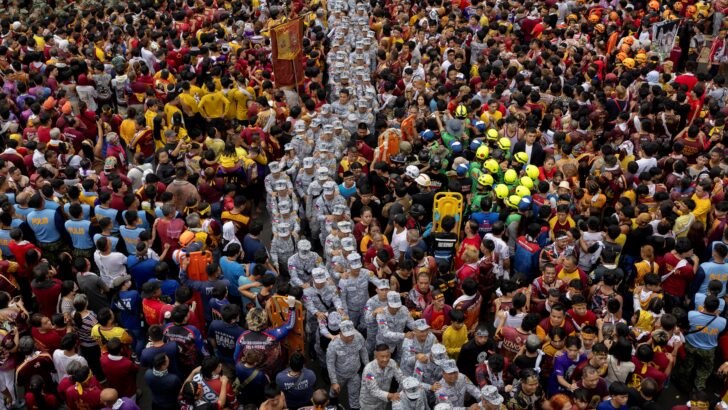The Black Nazarene procession in Manila, Philippines, which annually attracts one of the world’s largest crowds for a religious devotion, attracted hundreds of thousands of enthusiastic pilgrims on January 9.
Taking place each year in January, the procession, known locally as “Traslacion”, sees devotees carry across Manila a replica of a famous life-size statue of Jesus carrying a black wooden cross. The Philippines and East Timor are the only countries in Asia that are majority Catholic, with over 80% of the population of the Philippines belonging to the Church.
The procession’s organisers estimated that about 220,000 people attended Mass before the start of the procession, Rappler reported, and at least 800,000 people were gathered at the church Thursday evening, according to the Philippine Star. Hundreds of thousands more joined the procession as it went by.
As in past years, many of the devotees were barefoot and some even jumped onto the float and clutched at the cross carried by the famous statue. Rappler interviewed a 26-year-old British tourist at the procession, Adan Jeffrey, who said he was raised Catholic but now identifies as an atheist.
“I’ve never seen anything like it … the devotion that they have to wait that amount of time to kiss the statue is pretty phenomenal,” Mr Jeffrey said.
“I’ve never had a passion toward anything like these people have toward religion. So it’s amazing to see really, it’s an eye-opener.”
The Black Nazarene tradition was severely disrupted for several years by the COVID-19 pandemic; in 2020, 2021, and 2022 the procession was essentially cancelled entirely. In 2023, an estimated 103,277 faithful participated, far fewer than in past years.
Last year’s procession, in January 2024, marked a return to the procession’s typical size and fervour after three years of drastic downsizing. Also that year, the statue was placed in a glass case for the first time, and participants were banned from getting onto the float as they have in previous years, though many ignored the directive, UCA News, a Catholic Asian news site, reported at the time.
The image of Jesus used in the procession is believed to have been brought from Mexico to Filipino shores in 1606 by missionaries of the Order of Augustinian Recollects. The life-size statue of Jesus is today enshrined in the famous minor basilica popularly known as the Quiapo Church, located in the Archdiocese of Manila. First enshrined at St John the Baptist Church in Luneta, the image was transferred to Quiapo in 1868.


 Brandon Scott
Brandon Scott Filipino Coast Guard troops pass through the crowd during the annual procession of the Black Nazarene on its feast day in Manila January 9, 2025. The wooden statue, carved in Mexico and brought to the Philippine capital early in the 17th century, is cherished by Catholics, who believe that touching it can lead to a miracle. Photo: OSV News/Eloisa Lopez, Reuters.
Filipino Coast Guard troops pass through the crowd during the annual procession of the Black Nazarene on its feast day in Manila January 9, 2025. The wooden statue, carved in Mexico and brought to the Philippine capital early in the 17th century, is cherished by Catholics, who believe that touching it can lead to a miracle. Photo: OSV News/Eloisa Lopez, Reuters.